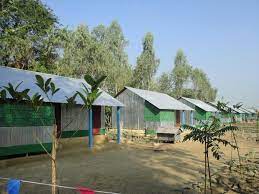
DHAKA, August 2, 2022 (BSS)-Father of the Nation Bangabandhu Sheikh Mujibur
Rahman rehabilitated 1,47,323 landless families through allocating 1,67,830
acres of khas land for them during his three and a half years tenure.
It was the Bangabandhu government who first took the initiatives for
constructing "Guchhcho Gram" (cluster villages) in the country to
rehabilitate the landless, distressed and river erosion-affected people.
As part of the initiatives, four cluster villages were built at Char Clark
under Subarna Char upazila in Noakhali, one at Diara Balua under Companyganj
upazila in Noakhali, one cluster village at Char Poragachha under Ramgati
upazila in Laksmipur and one at Char Darbesh under Sonagazi upazila in Feni
district.
As many as 1,470 families were rehabilitated in the cluster
villages.
At the beginning of rebuilding the war-ravaged country, Bangabandhu embarked
on rehabilitation and arrangement for food for two crore
displaced people. In this regard, he took a six-month-long rehabilitation
programme till June 1972.
The aim of the programme was to bring back the refugees from India,
arrange temporary housing for homeless people and reestablish farmers,
workers, blacksmiths, potters and weavers in their economic life.
Nearly one crore refugees returned home from India by January 1972. With
the cooperation of the United Nations (UN) and other friendly countries, the
Bangabandhu government placed a "Rehabilitation Budget" having the Annual
Development Programme of Taka 550 core without imposing any fresh tax.
The government constituted the Planning Commission and later adopted the
first five-year plan with Taka 4,455 core.
Under the post-war rehabilitation programmes, arrangements were made to
distribute 1.41 lakh maunds of food grains, reconstruct nine lakh houses and
disburse 9,000 plots among the landless, distressed and affected people.
The government houses worth about Taka 10 crore were damaged in the
Liberation War, while the devastation in the private sector houses was Taka
825 crore.
To solve the housing problem, necessary money was allocated by dividing
the rebuilding work into 10 sectors. These are the Building Directorate,
Khulna Development Authority, Dhaka Improvement Trust, Chittagong Development
Authority, the Department of Works, the Department of Fire Service, the
Department of Police, Parjatan Corporation and Bangladesh Rifles Survey
Department.
At the initiatives of Bangabandhu, arrangement for money was made in the
"Cyclone Preparedness Programme". As a result, training was given to 20,430
volunteers, while over 100 multi-storied shelter centres and 137
"Matir Kellas" with 15-metre high each were constructed.
There were arrangements for shelter of livestock alongside the people in
these soil-made forts which are locally known as "Mujib Kella".
Bangabandhu inaugurated a Mujib Kella at Poragachha under Ramgati upazila
in Laksmipur on February 20 in 1972 and asked the then Noakhali district
administration to rehabilitate the river erosion-affected, distressed and
homeless people on the government khash lands.